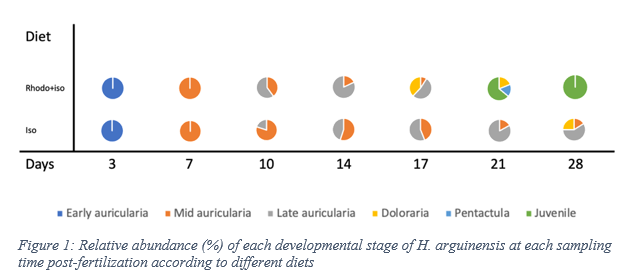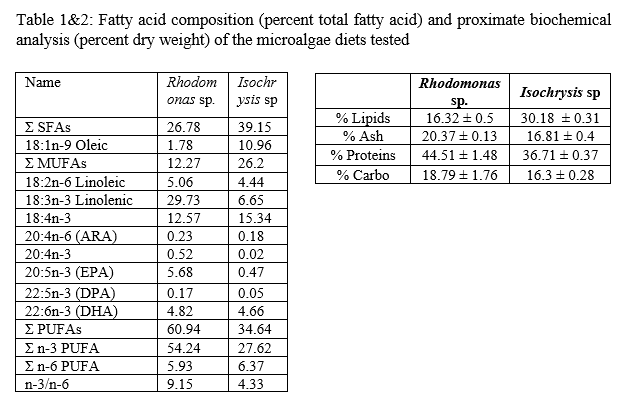EFFECTS OF SINGLE AND COMBINED MICROALGAE ON LARVAL GROWTH, DEVELOPMENT AND SURVIVAL OF THE SEA CUCUMBER Holothuria arguinensis
Introduction
The overexploitation of wild sea cucumber stocks calls for sustainable aquaculture to meet demand and aid conservation (Purcell et al., 2012). Holothuria arguinensis , valued for its commercial potential and facing population declines, is a strong aquaculture candidate (Domínguez-Godino & González-Wangüemert, 2020). Production success depends on optimizing larval rearing, particularly microalgal diets with suitable nutritional profiles to support growth, development and survival (Domínguez-Godino & González-Wangüemert, 2019; Sibonga et al., 2021). In related species like H. scabra and Apostichopus japonicus , diets rich in protein, lipids, and essential fatty acids (EPA, DHA) have improved larval performance (Duy et al., 2016; Sibonga et al., 2021). Despite these advances , the role of microalgae such as Rhodomonas (Yamamoto et al., 2015) in H. arguinensis have not been thoroughly investigated , and understanding the link between algal composition and larval development is essential for refining hatchery protocols . This study aims to evaluate the effects of Rhodomonas sp. and Isochrysis sp. diets, on the growth, development, and survival of H. arguinensis larvae to contribute to the development of effective feeding strategies for its aquaculture.
Material and methods
Broodstock, larvae and microalgae diets
Adult specimens of H. arguinensis were induced to spawn by thermal stimulation . At 24 h post-fertilization, larvae were stocked at 0.75 eggs/mL in 200 L conical tanks with 1 μm filtered, UV-sterilized seawater, renewed daily by 50%. Triplicate 50 mL samples were taken twice weekly for four weeks to monitor larval stages. Ten larvae per replicate were photographed upon stage transitions, with length and width measured using ImageJ Software . Larvae were fed daily with either a mixed diet of Rhodomonas sp. and Isochrysis sp. (5000 cells/mL each) or Isochrysis sp. alone (10,000 cells/mL). Isochrysis sp. microalgae were cultured in 5 L glass flasks and Rhodomonas sp. in 20 L polyethylene bags, both using sterilized seawater with F/2 medium (Guillard, 1975), under a 16:8 h light : dark cycle at room temperature. Cultures were harvested and counted daily using a Neubauer chamber.
Biochemical analysis
Proximate analysis of the microalgae was conducted using standard procedures (AOAC, 2023) and fatty acids analysis and identification was performed according to the protocols of Duy et al. (2016 ).
Results and discussion
Unlike the findings of Duy et al. (2016) and Sibonga et al. (2021), no significant differences in auricularia larval length were observed across treatments from day 3 to 28 (P > 0.05). However, larvae were generally larger than those reported for H. arguinensis in previous studies (Domínguez-Godino & González-Wangüemert, 2019; Sousa et al., 2023). Late-stage auriculariae fed a mixed diet including Rhodomonas sp. were longer (1002.42 ± 148.59 μm) and significantly wider (744.31 ± 130.57 μm) than those fed Isochrysis sp. alone (981.71 ± 130.97 μm; 664.29 ± 116.88 μm). This may reflect the higher protein and EPA, and lower lipid content of Rhodomonas sp. (Tables 1 & 2), previously linked to enhanced larval performance (Duy et al., 2016). Its inclusion also significantly improved survival at days 14 and 21 (62.11 ± 3.65% and 41.33 ± 2.41%) compared to Isochrysis sp. (40.44 ± 2.91% and 26.66 ± 10.07%), and accelerated the appearance of the doliolaria and juvenile stages by 10 days.
References
AOAC. 2023. Official methods of analysis of AOAC international.
Domínguez-Godino, J.A., & González-Wangüemert, M. (2020 ). Aquat Ecol 54, 337–354.
Domínguez-Godino, J. A., & González-Wangüemert, M. (2019). Aquaculture Research, 50 , 3130–3137.
Duy, N. D. Q., Francis, D. S., Pirozzi , I., & Southgate, P. C. (2016). Aquaculture, 464, 145–152.
Guillard RRL. 1975. Culture of phytoplankton for feeding marine invertebrates. In: Smith WL, Chanley MH, editors. Culture of marine invertebrate animals. New York: Plenum; p. 29–60.
Purcell, S. W., Hair, C. A., & Mills, D. J. (2012). Aquaculture, 368-369, 68–81.
Sibonga, R. C., Laureta, L. V., Lebata-Ramos, M. J. H., Nievales, M. F. J., & Pedroso, F. L. (2021). Journal of Applied Phycology , 33, 3103–3112.
Sousa, J.; Félix, P.M.; Brito, A.C.; Venâncio, E.; Azevedo e Silva, F.; Simões, T.; Amorim, A.; Dâmaso-Rodrigues, M.L.; Pombo, A. Diversity 2023, 15 , 722.
Yamamoto, S., Okauchi, M., & Yoshimatsu, T. (2015). Nippon Suisan Gakkaishi, 81(6), 973–978.

